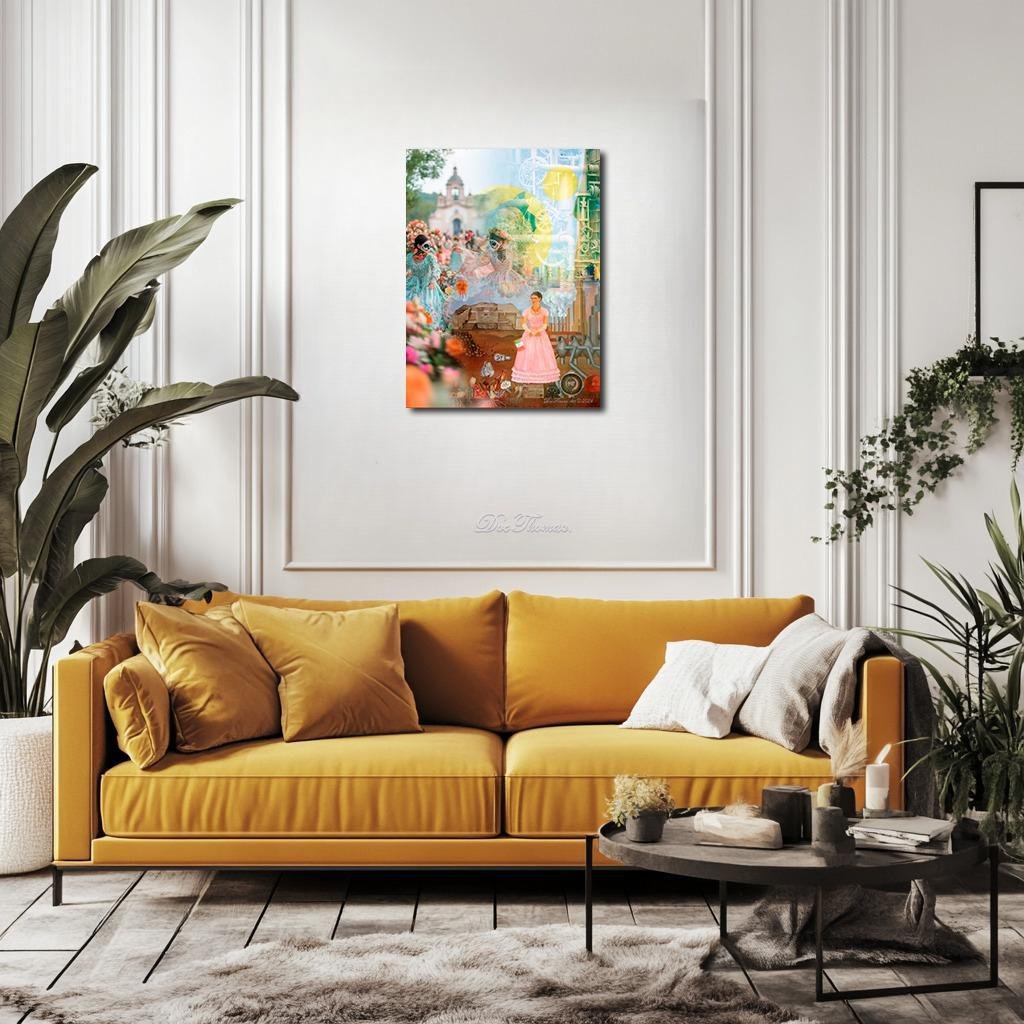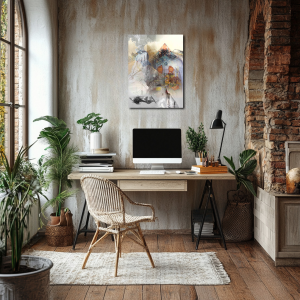Threshold of Two Worlds: Frida’s Dual Inheritance
Threshold of Two Worlds reimagines Frida Kahlo’s Self-Portrait on the Borderline Between Mexico and the United States as a vibrant, surreal collision of ancestral ritual and mechanical modernity. Through rich siennas, tangerine blooms, icy teals, and digitized golds, Kahlo’s figure bridges life and machine, memory and exile. Surrounded by dancing skeletons and silent steel, she stands as a sovereign body between clashing realities, rooted not in one nation, but in the unshakable truth of her own becoming.
Please see Below for Details…
Hotline Order:
Mon - Fri: 07AM - 06PM
404-872-4663
This conceptual reimagining of Frida Kahlo’s Self-Portrait on the Borderline Between Mexico and the United States transforms her visual protest into a lyrical meditation on duality, displacement, and ancestral belonging. Titled Threshold of Two Worlds , the piece expands Kahlo’s iconic stance into a layered dream of clashing identities—where death dances beside mechanization, and flowers bloom defiantly along the border of memory and modernity. She does not merely stand between nations; she stands between truths—cultural, personal, and cosmic.
At the heart of the composition, Frida appears dressed in soft pink, her hands folded and face solemn, a Mexican flag resting gently in one hand. Her expression is poised and calm, but the elements around her are in restless dialogue. On her left stretches a rich, folkloric Mexico—lush with Aztec pyramids, calaveras, blooming marigolds, and the skeletons of Día de los Muertos weaving through fields of orange and crimson flowers. A chapel looms beyond the mist, suggesting the enduring breath of ritual and communal mourning. Two women in skeletal face paint—La Catrina figures—glide in ceremonial grace, as if guarding the memory of what must not be erased.
To her right, the world fractures into a pale storm of glass, gears, and steel pipes—a surreal skyline of industrial America rendered in icy teals, smokey grays, and bright sterile whites. Enormous yellow mechanical suns hover like artificial replacements of cosmic truth, while circuit grids and clockwork cogs turn silently behind hazy acrylic light. The land is no longer earth but concrete, no longer breath but machine.
The color treatment of Threshold of Two Worlds is deliberately bifurcated yet blended at the edges. Mexico’s half radiates with warm, sensuous hues: sun-drenched tangerines, earthy siennas, magentas blooming like blood, and the lush jungle greens of memory and ritual. These tones are not merely aesthetic—they breathe with life and death, mourning and harvest. The sky above the Mexican side is a soft, diffused rose and dusky lavender, as if shaped by generations of prayers.
In contrast, the American half is swathed in processed chromatics—icy cyan, muted chrome, and digitized gold. The sun here is abstract and imposed, lacking the warmth of nature, casting shadows shaped like exhaust. The steel pillars rise like inorganic trees, their growth cold and determined, mirroring a civilization driven by consumption rather than communion.
Frida’s body splits this landscape, her dress echoing the pinks of Mexican flowers but edged with the cool lighting from the mechanical world. Her necklace—a chain of thorns—rests gently above her collarbone, reminding us that this choice between worlds was not romantic, but necessary, and filled with pain. From the hem of her dress, flowers and wires mingle—suggesting that even the body becomes a site of collision and creation.
Subtle elements around her speak in metaphors: tiny Aztec artifacts rest beneath her feet, half-buried in the soil. On the industrial side, a lightbulb blooms like a manufactured flower. Between the skeleton dancers and the cogwheels hovers a hazy middle-space, almost a liminal cloud, where identity, nation, and self dissolve into motion. This is the border—not merely geographic but existential.
When I created Threshold of Two Worlds , I wanted to capture the psychic and spiritual landscape behind Kahlo’s original painting. She did not simply critique American capitalism; she mourned the disconnection it fostered. She did not merely glorify Mexico; she honored the life and death cycles, the deep-rooted mythologies that gave her identity form and texture. In this piece, I wanted to let those forces swirl, not in opposition, but in unresolved rhythm—because Frida never fully left either side. She stood on the threshold not to choose, but to witness.
The composition flows in opposing spirals—one curling from the cathedral and flowers toward Frida’s heart, the other spinning outward from the smokestacks and clockwork suns into an endless horizon of glass. Frida is the still point between them. Her gaze does not flinch. She does not plead for belonging. She roots herself as a sovereign figure, grounded in the knowledge that one can exist between worlds and still be whole.
In this vision, Frida Kahlo is the border itself—not its victim, not its conqueror, but its conscious embodiment. She holds the contradictions, the inheritances, the ruptures, and the blooms. And from that unstable ground, she becomes the most solid figure of all.
Add your review
Your email address will not be published. Required fields are marked *
Please login to write review!
Looks like there are no reviews yet.








